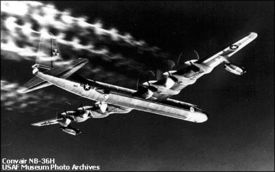PlaneSpottingWorld welcomes all new members! Please gives your ideas at the Terminal.
Convair X-6
| Convair X-6 | |
|---|---|
| Convair NB-36H flying nuclear reactor testbed | |
| Type | Experimental aircraft |
| Manufacturer | Convair |
| Maiden flight | Not flown |
| Status | Cancelled |
| Primary user | USAF |
The Convair X-6 was a proposed experimental aircraft project to develop and evaluate a nuclear-powered jet aircraft. The project was to use a Convair B-36 bomber as a testbed aircraft, and though one NB-36H was modified during the early stages of the project, the program was cancelled before the actual X-6 and its nuclear reactor engines were completed. The X-6 was part of a larger series of programs, costing US$7 billion in all, that ran from 1946 through 1961. Because such an aircraft's range would not have been limited by liquid jet fuel, it was theorized that nuclear-powered strategic bombers would be able to stay airborne for weeks at a time.[1]
Contents
History
In May, 1946, the Nuclear Energy for the Propulsion of Aircraft (NEPA) project was started by the Air Force. Studies under this program were done until May, 1951 when NEPA was replaced by the Aircraft Nuclear Propulsion (ANP) program. The ANP program contained plans for two B-36s to be modified by Convair under the MX-1589 project. One of the B-36s was to be used to study shielding requirements for an airborne reactor while the other was to be the X-6.
Nuclear Test Aircraft
The first modified B-36 was called the Nuclear Test Aircraft (NTA), a B-36H-20-CF (Serial Number 51-5712) that had been damaged in a tornado at Carswell AFB on September 1, 1952. This plane was redesignated the XB-36H, then the NB-36H and was modified to carry a 3 megawatt, air-cooled nuclear reactor in its bomb bay. The reactor, named the Aircraft Shield Test Reactor (ASTR), was operational but did not power the plane. Water, acting as both moderator and coolant, was pumped through the reactor core and then to water-to-air heat exchangers to dissipate the heat to the atmosphere. Its sole purpose was to investigate the effect of radiation on aircraft systems.
To shield the flight crew, the nose section of the aircraft was modified to include a 12-ton lead and rubber shield. The standard windshield was replaced with one made of 6-inch–thick acrylic glass. The amount of lead and water shielding was variable. Measurements of the resulting radiation levels were then compared with calculated levels to enhance the ability to design optimal shielding with minimum weight for nuclear-powered bombers.
The NTA completed 47 test flights and 215 hours of flight time (during 89 of which the reactor was operated) between July 1955 and March 1957 over New Mexico and Texas.[1] This was the only known airborne reactor experiment by the U.S. with an operational nuclear reactor on board. The NB-36H was scrapped at Fort Worth in 1958 when the Nuclear Aircraft Program was abandoned. After the ASTR was removed from the NB-36H, it was moved to the National Aircraft Research Facility.
Based on the results of the NTA, the X-6 and the entire nuclear aircraft program was abandoned in 1961.
Development plans
Had the program progressed, follow-on aircraft would have been based on the successor to the B-36, Convair's swept-wing B-60.[2]
The X-6 would have been powered by General Electric X-39 engines, utilizing a P-1 reactor.[3] In a nuclear jet engine, the reactor core was used as a heat source for the turbine's air flow, instead of burning jet fuel. One disadvantage to the design is that since the airflow through the engine was used to cool the reactor, this airflow had to be maintained even after the aircraft landed and parked.[2] GE built two prototype engines, which can be seen outside the Experimental Breeder Reactor I in Arco, Idaho.[1]
A large, 350-foot (160.7 meter-) wide hangar was built at Test Area North, part of the National Reactor Testing Station (now part of the Idaho National Laboratory), Monteview, Idaho to house the X-6 project, but the project was cancelled before the planned 15000-foot (4572m) runway was built. The length was necessitated by the expected weight of the nuclear-powered aircraft.[2]
Russian program
In the Sixties, the Soviet Union's Tupolev design bureau conducted a similar experiment using a Tupolev Tu-119, which was a Tu-95 bomber modified to carry an operational reactor.
Specifications (NB-36H)
General characteristics
- Crew: Five
- Length: 162 ft (49.38 m)
- Wingspan: 230 ft (70.1 m)
- Height: 46 ft 9 in (14.26 m)
- Wing area: 4,770 ft² (443.3 m²)
- Max takeoff weight: 360,000 lb (163,000 kg)
- Powerplant:
- 4× General Electric X40 turbojets, () each
- 6× Pratt & Whitney R-4360-53 , 3,800 hp (2,830 kW) each
Performance
- Maximum speed: 390 mph (628 km/h)
- Service ceiling: 40,000 ft (12,200 m)
See also
Comparable aircraft
References
External links
- Dream of Atomic-Powered Flight original published on Aviation History, March 1995.
- Joe Baugher. B-36 Peacemaker. Section devoted to NB-36H
Template:Convair aircraft Template:X-planes
Lists relating to aviation | |
|---|---|
| General | Timeline of aviation · Aircraft · Aircraft manufacturers · Aircraft engines · Aircraft engine manufacturers · Airports · Airlines |
| Military | Air forces · Aircraft weapons · Missiles · Unmanned aerial vehicles (UAVs) · Experimental aircraft |
| Notable incidents and accidents | Military aviation · Airliners · General aviation · Famous aviation-related deaths |
| Records | Flight airspeed record · Flight distance record · Flight altitude record · Flight endurance record · Most produced aircraft |
de:Convair X-6 es:Convair X-6 it:Convair X-6 hu:X–6 ja:X-6 (航空機) no:Convair X-6 pl:Convair X-6 tr:Convair X-6 zh:X-6試驗機
| This article is licensed under the GNU Free Documentation License. It uses material from the Wikipedia article "Convair X-6". |

